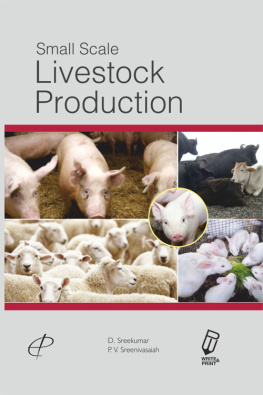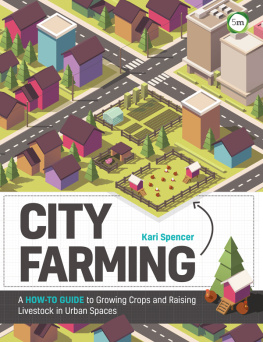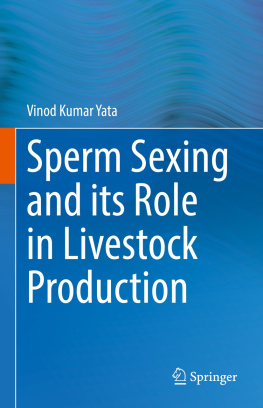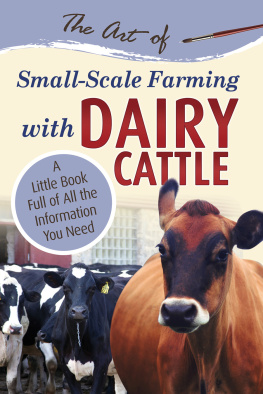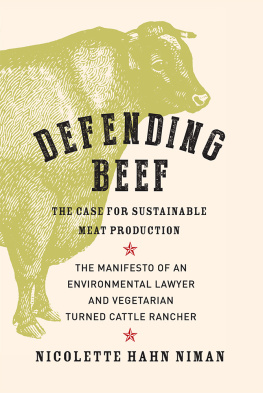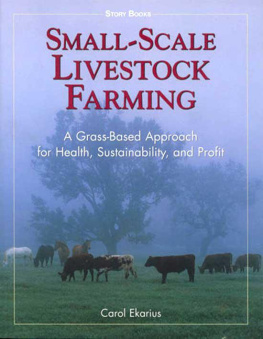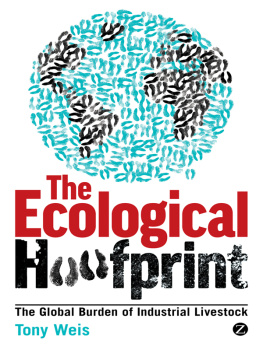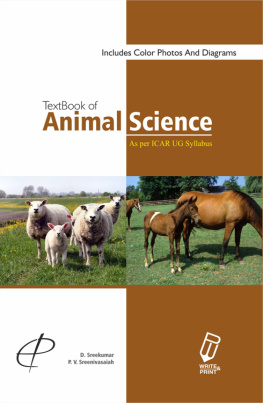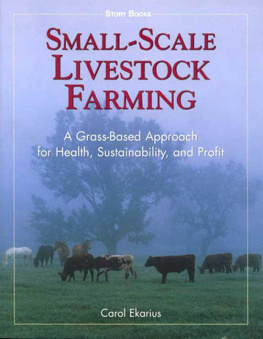D. SREEKUMAR - Small Scale Livestock Production
Here you can read online D. SREEKUMAR - Small Scale Livestock Production full text of the book (entire story) in english for free. Download pdf and epub, get meaning, cover and reviews about this ebook. year: 2014, publisher: Mint Associates Ltd, genre: Children. Description of the work, (preface) as well as reviews are available. Best literature library LitArk.com created for fans of good reading and offers a wide selection of genres:
Romance novel
Science fiction
Adventure
Detective
Science
History
Home and family
Prose
Art
Politics
Computer
Non-fiction
Religion
Business
Children
Humor
Choose a favorite category and find really read worthwhile books. Enjoy immersion in the world of imagination, feel the emotions of the characters or learn something new for yourself, make an fascinating discovery.
- Book:Small Scale Livestock Production
- Author:
- Publisher:Mint Associates Ltd
- Genre:
- Year:2014
- Rating:5 / 5
- Favourites:Add to favourites
- Your mark:
- 100
- 1
- 2
- 3
- 4
- 5
Small Scale Livestock Production: summary, description and annotation
We offer to read an annotation, description, summary or preface (depends on what the author of the book "Small Scale Livestock Production" wrote himself). If you haven't found the necessary information about the book — write in the comments, we will try to find it.
Small Scale Livestock Production — read online for free the complete book (whole text) full work
Below is the text of the book, divided by pages. System saving the place of the last page read, allows you to conveniently read the book "Small Scale Livestock Production" online for free, without having to search again every time where you left off. Put a bookmark, and you can go to the page where you finished reading at any time.
Font size:
Interval:
Bookmark:
Abbreviations
| A/c | Account |
| AI | Artificial insemination |
| Approximately | |
| Cm | Centimeter |
| cft | Cubic feet |
| D | day/days |
| Degrees | |
| C | Degrees Celsius |
| F | Degrees Farenheit |
| Eg. | Example |
| FCR | Feed Conversion Ratio |
| Ft | Feet |
| FYM | Farm Yard Manure |
| GI | Galvanized Iron |
| G | Girth |
| G | gram/grams |
| > | Greater than |
| > | Greater than or equal to |
| HCHO | Formaldehyde |
| HF | Holstein Friesian |
| Ha | Hectare |
| H2O2 | Hydrogen Peroxide |
| Hr | hour/hours |
| In | Inches |
| i.e | That is |
| Kg | Kilogram / kilograms |
| KMnO4 | Potassium Permanganate |
| In | Inches |
| < | Less than |
| < | Less than or equal to |
| L | Length |
| Lb | Pounds |
| Lit | Liter |
| M | Million/millions, meter/meters |
| mg | Milligram |
| Ml | Milliliter |
| mm | Millimeter |
| min | Minutes |
| NH4OH | Ammonium hydroxide |
| ppm | parts per million, mg/kg |
| / | Per |
| p.a | Per annum |
| PVC | Poly vinyl chloride |
| % | Percent |
| PI | Persistency index |
| q.s | Quantum sufficient |
| RCC | Reinforced Cement Concrete |
| RH | Relative humidity |
| Re | Rupee |
| Rs | Rupees |
| seer | An old unit of measurement; equivalent of 0.93 kg |
| Sq ft | Square feet |
| T | Tonne |
| t/ha | Tones/hectare |
| Vs | Versus |
| w/v | Weight by volume |
| Yr | Year |
Appendix 1
Livestock Housing
Proper house is compulsory not only to protect the animals from the extremes of environment but also to get maximum production by them. It is better to have a less expensive and more comfortable house for animals.
Nomenclature of houses for various farm animals is as follows:
1. Dairy animals: Barn or Byre
2. Pigs: Sty
3. Rabbits: Hutch
4. Sheep and Goats: Pen
Housing requirements for animals vary with the species of animal as well as type or category like weaners, growers, breeders, dry animals, pregnant animals etc. The type and design of the animal house will vary according to the region / location. For example, in the plains the height of the building should be more for effecting good ventilation and in high altitude areas, the height of the house could be slightly less.
A good animal house should:
1. Provide warmth and comfort
2. Have adequate light and ventilation
3. Be convenient to clean and disinfect as and when required
4. Include good drainage facility
5. Provide safety (from injury, from escape)
6. Have separate provision for keeping animals of different categories and sick animals
7. Be labor efficient
1. What are the benefits of proper housing?
1. House provides protection and comfortable environment for optimum production
2. It facilitates workers attending on the animals
3. Affords protection to the animal from cold, heat, wind, rain etc.
4. Feeding and watering can be easily monitored (and controlled)
2. House structure
2.1. Foundation
A strong foundation is required for any shed.
2.2. Floor
The floor of the barn should be hard and non-slippery, impervious to water and easy to clean. Generally, it is made of cement concrete or by paving bricks.
2.3. Floor space recommendations
To calculate the dimensions of any building, it is mandatory that information regarding number, type and age of animals are available along with their respective floor space requirement. If there are any restrictions on length and / or width of the sty to be constructed, such information should be taken care of while the design is finalized. Similarly, if more than one building has to be constructed, location and separation distance between the buildings also have to be finalized on scientific norms.
2.4. Wall
Wall is the structure that supports the roof and should not absorb moisture. Wall is usually made of bricks and corners are to be rounded off.
2.4.1. Why?
Sharp corners would harbor pests and parasites such as ticks, lice, insects etc., which, in turn, can cause discomfort and/or disease(s) to the animals.
2.5. Roof
Should be strong, durable, weather-proof, bad conductor of heat and should not allow condensation of water toward inner surface.
2.5.1. Material for roof
Roof can be made of thatch, asbestos, tiles, PVC sheet or RCC. PVC sheet would be ideal for a barn to house a small herd as it would be cheap, light in weight and permits natural light inside. Since, only a small herd is taken into consideration in the present case, the roof could be of a single slope (Shed type house). For such a building, the supporting walls or posts should be higher on one side. Under rural conditions, farmers can even go for constructing a lean to type shed; where in the shed is alongside the home.
Double slope roof should be used in large sized barns, especially in double row sheds that are generally used to house more than 20 animals.
2.5.1.1. What is overhang and how much is recommended?
An overhang is the projection of the roof outside eaves to prevent water/ rain water seepage into the building. Generally, an overhang (0.9 to 1.2 m; 3 to 4 ft) is provided. The horizontal distance between tip of the overhang and the side wall should be at least 1 m (3.3 ft).
Caution: Seepage of rain water from the side wall without overhang may be a problem in shed type houses especially in medium and heavy rainfall areas.
2.5.1.2. What is Pitch and what is its purpose?
Pitch is the angle between Run and the roof at the eaves. Hence, pitch provides a gradient (25 to 33) in the roof to facilitate flow of rain-water.
2.5.1.3. Can the same pitch be employed for all types of roof?
No. If the roof is made of thatches, pitch should be at least 45 to ensure quick drainage of water especially during heavy rain and prevent seepage of water into the shed through the thatch material. With tiles, a pitch of 30 is generally advised. In case of aluminium sheets or asbestos, pitch as less as 5 to 10 also can serve the purpose.
Caution: Pitch < 45 in thatched roof buildings is likely to leak and/or give in due to weight of water during heavy to very heavy rain.
Note:
1. The pitch angle can be approximated as the ratio of rise to span times 100
2. In hot regions, it is preferable to paint the top surface of the roof white (to reflect radiant heat) and the lower surface, black
2.6. Manger
A trough or a box like structure used to offer feed and fodder to to animals is called a Manger. Rabbits are generally reared in cages or on litter; in either case, they require different type of feeding equipment which will be discussed under Section: Rabbits Chapter: Housing
2.6.1. What are the recommendations for manger?
1. Should be made of a hard, impervious material (preferably concrete)
Next pageFont size:
Interval:
Bookmark:
Similar books «Small Scale Livestock Production»
Look at similar books to Small Scale Livestock Production. We have selected literature similar in name and meaning in the hope of providing readers with more options to find new, interesting, not yet read works.
Discussion, reviews of the book Small Scale Livestock Production and just readers' own opinions. Leave your comments, write what you think about the work, its meaning or the main characters. Specify what exactly you liked and what you didn't like, and why you think so.

